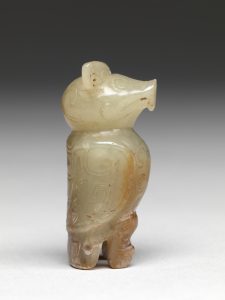As SCMA’s first significant acquisition of ancient Chinese art, the Hart Collection marked a turning point in the museum’s history. Ivan B. Hart was a Dutch wool merchant who had immigrated to the United States in 1940 with his family, and both he and his wife were avid collectors of a wide range of artworks. Originally unrelated to Smith College and philanthropically inclined, Hart and his wife gifted their collection to many academic museums including Smith College Museum of Art in 1959.
Hart’s Collection of 53 archaic Chinese jades was first brought together by the late S.H. Minkenhof (1879-1956) of Amsterdam and later of Paris and New York, who, like Hart, was a Dutch businessman. Minkenhof was not only a thoughtful and discerning collector but also a student and a connoisseur, who devoted himself to studying and collecting Chinese bronze and jade after his retirement from importing and exporting textiles around the world. One of the critical figures in helping form the Minkenhof collection of early Chinese jade is Professor Alfred Salmony (1890-1958) of the Institute of Fine Arts at NYU, who was one of the leading scholars in “Oriental” art.
The acquisition of the Hart Collection in the 1950s coincided with the introduction of Asian Studies to Smith’s curriculum. The provenance of this collection reflects one of the many motivations for early American collecting of Chinese artworks: for the purpose of studying them and the culture behind them. Many avid collectors became experts or scholars in the field of Chinese art, and their close relations with academic institutions helped to establish Chinese objects as art instead of ethnographic materials. During this period, Chinese archaic jades and bronzes were among the most pursued objects since they were considered representatives of Chinese art. The Jade Owl, for example, owing to its association with the ancient power of preservation, fascinated the American collectors at the beginning stage of collecting Chinese art.
